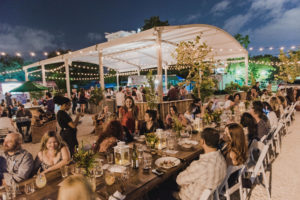
Wynwood Yards—wow!
Recently, Bisnow Media convened a panel devoted to the remarkable rise of Wynwood, a super cool neighborhood in Miami.
The panel consisted of developers, investors and others who have been instrumental in the revitalization of a tired neighborhood into a hip, tourist draw and arts center.
Their conclusion: zoning was the key to the neighborhood’s success.
According to Bisnow: “Fortis Design+Build Managing partner David Polinsky said when Wynwood started becoming a hot neighborhood with galleries and street art, he had looked at a tract behind Panther Coffee and bought it the next day — only to find there was nothing he could build on it.
In 2013, he helped write a white paper that laid out three planning and zoning goals: relaxed parking requirements, zoning that would permit flexible uses such as residential and office and increased density for residential development.
The Wynwood Business Improvement District, which represents more than 400 property owners, worked with the city of Miami and planning firm PlusUrbia and, in 2015, developed a Neighborhood Revitalization Plan, which called for 10-foot-wide sidewalks, the development of studio apartments under 650 SF and the establishment of a design review committee that would consider future projects. Eventually, the city passed eight ordinances that incorporated the changes.”
The changes created value that didn’t exist before. And the magic of those zoning changes is that the value didn’t cost the taxpayers a fortune. Unlike expensive incentives and tax abatements, increasing flexibility (especially for urban infill sites) is the best tool cities have to create value, attract investment and transform neighborhoods. Zoning beats costly incentives my friends.
But success has its challenges too.
While Wynwood has won international acclaim, rents have soared squeezing out the eclectic array of small businesses that made the neighborhood attractive to begin with. Rents are now said to be between $40 and $100 per square foot, that’s very pricey for independents. On nearby Lincoln Road which started losing independents in 1999 rents can be as high as $330 a square foot.
Locally, we have experienced a similar phenomenon.
When I moved to Delray in the late 80s, Atlantic Avenue rents were $6-8 a square foot. Adjusted for inflation that would be the equivalent of $13-$17 a square foot in 2018 numbers. But today rents are $50 to over $100 a square foot downtown. That’s a challenge. Fortunately, the Downtown Development Authority recognizes that there are issues and has engaged Robert Gibbs, a noted expert, to help navigate. The city would be wise to listen to Gibbs’ 43 page analysis which is available on the DDA website. I don’t agree with it all, but it’s fascinating reading.
Urban redevelopment is often the tale of revitalization and then hyper gentrification which ultimately squeezes the charm out of a place. While change is inevitable (even Charleston, S.C. has chain stores up and down its main drag) it doesn’t always have to mean doom and gloom. There are tools—rental assistance (which can be controversial), pop-up store opportunities to test ideas, retail incubators and small liner shops that can help promote authentic and independent uses.
But it isn’t easy. And you’re never done.
That was a mantra back when Atlantic Avenue was making the turn from “Dull Ray” to “America’s Most Fun Town.”
There’s always a chorus of people who will be saying it’s time move on and concentrate elsewhere once you find some success.
But city building is never a zero sum binary game.
You can do many things at once—and you should: each part of your city deserves its own strategy and investment plan—but you’ll never be totally done. Success is never final and with it comes challenges; many unexpected.
Wynwood is at an inflection point. I would argue that downtown Delray Beach and east Boca is as well. Mind you, these are good problems to have. They certainly beat the alternative which is our “town is dead, what do we do?”
I drove Atlantic Avenue with my dogs on a recent Sunday evening. It was a hot steamy off season night and it was nice to see crowds of pedestrians and diners—people of all ages enjoying the avenue. I noticed some vacancy and I also noticed that our streets could be cleaner. But I also saw vibrancy, hard fought, hard to get and harder to keep vibrancy.
The dogs stuck their heads out the window to check it out and soak it in. It felt good and it’s something we should cherish and work together to keep.
The challenges are not unique, but the opportunities are very unique. Consider me grateful. There’s something cool about never being done. It allows all of us to be part of an ongoing story.
